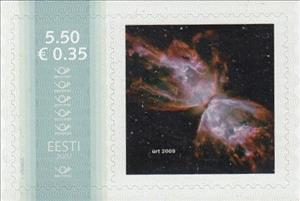Stamp with Attached Label: The Butterfly Nebula (Personalized and Private Mail Stamps 2007)
The Butterfly Nebula (Personalized and Private Mail Stamps 2007)
22 February (Personalized and Private Mail Stamps ) within release Estonia : Minu Mark goes into circulation Stamp with Attached Label The Butterfly Nebula face value 5.50 Estonian kroon
| Stamp with Attached Label The Butterfly Nebula in catalogues | |
|---|---|
| Colnect codes: | Col: EE 0005245 |
Stamp with Attached Label is horizontal format.
Also in the issue Estonia : Minu Mark:
- Stamp with Attached Label - Camel face value 5.50;
- Stamp with Attached Label - Camel face value 5.50;
- Stamp with Attached Label - Camel face value 5.50;
- Stamp with Attached Label - Eesti Keele Instituut face value 5.50;
- Stamp with Attached Label - Eesti Keele Instituut face value 5.50;
- Stamp with Attached Label - Els face value 5.50;
- Stamp with Attached Label - Geniteh OÜ face value 5.50;
- Stamp with Attached Label - Innopolis Insenerid OÜ face value 5.50;
- Stamp with Attached Label - Kopkop face value 5.50;
- Stamp with Attached Label - Lundbeck Pharmaceuticals face value 5.50;
- Stamp with Attached Label - Man face value 5.50;
- Stamp with Attached Label - Man face value 5.50;
- Stamp with Attached Label - Open Estonian Foundation Avatud eesti Fond 20 aastat face value 5.50;
- Stamp with Attached Label - Toy Museum. Iloni Imedemaal face value 5.50;
- Stamp with Attached Label - Uno Kruus 75 face value 5.50;
- Stamp with Attached Label - Abt As face value 5.50;
- Stamp with Attached Label - Forss face value 5.50;
- Stamp with Attached Label - Eesti Keele Instituut. Pöidlad pihku. face value 5.50;
- Stamp with Attached Label - Eesti Keele Instituut. Taristu. face value 5.50;
- Stamp with Attached Label - Hepatitis C viirus face value 5.50;
- Stamp with Attached Label - Hopf stabilization face value 5.50;
- Stamp with Attached Label - Ruumide põrge face value 5.50;
- Stamp with Attached Label - The Butterfly Nebula face value 5.50;
- Stamp with Attached Label - Gustav Ernesaks face value 5.50;
- Stamp with Attached Label - Kadrioru park face value 5.50;
- Stamp with Attached Label - Men motorcycles face value 5.50;
- Stamp with Attached Label - Tree face value 5.50;
- Stamp with Attached Label - Uisge Beatha Club face value 5.50;
- Stamp with Attached Label - Koer face value 5.50;
- Stamp with Attached Label - Lill face value 5.50;
- Stamp with Attached Label - Mercedes face value 5.50;
- Stamp with Attached Label - Mulgi rahvariietes paar face value 5.50;
- Stamp with Attached Label - Saksa Auto kaks face value 5.50;
Stamp with Attached Label The Butterfly Nebula it reflects the thematic directions:
Insects (from Latin insectum, a calque of Greek ἔντομον [éntomon], "cut into sections") are a class (Insecta) of hexapod invertebrates within the arthropod phylum that have a chitinous exoskeleton, a three-part body (head, thorax and abdomen), three pairs of jointed legs, compound eyes and one pair of antennae. They are the most diverse group of animals on the planet, including more than a million described species and representing more than half of all known living organisms. The number of extant species is estimated at between six and ten million, and potentially represent over 90% of the differing animal life forms on Earth. Insects may be found in nearly all environments, although only a small number of species reside in the oceans, a habitat dominated by another arthropod group, crustaceans. The life cycles of insects vary but most hatch from eggs. Insect growth is constrained by the inelastic exoskeleton and development involves a series of molts. The immature stages can differ from the adults in structure, habit and habitat, and can include a passive pupal stage in those groups that undergo 4-stage metamorphosis (see holometabolism). Insects that undergo 3-stage metamorphosis lack a pupal stage and adults develop through a series of nymphal stages. The higher level relationship of the Hexapoda is unclear. Fossilized insects of enormous size have been found from the Paleozoic Era, including giant dragonflies with wingspans of 55 to 70 cm (22–28 in). The most diverse insect groups appear to have coevolved with flowerin plants.
Science is a systematic discipline that builds and organises knowledge in the form of testable hypotheses and predictions about the universe.Modern science is typically divided into two or three major branches: the natural sciences (e.g., physics, chemistry, and biology), which study the physical world; and the behavioural sciences (e.g., economics, psychology, and sociology), which study individuals and societies.The formal sciences (e.g., logic, mathematics, and theoretical computer science), which study formal systems governed by axioms and rules, are sometimes described as being sciences as well; however, they are often regarded as a separate field because they rely on deductive reasoning instead of the scientific method or empirical evidence as their main methodology. Applied sciences are disciplines that use scientific knowledge for practical purposes, such as engineering and medicine


